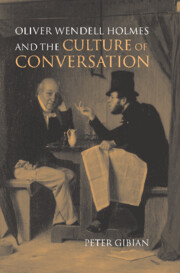Book contents
- Frontmatter
- Contents
- Acknowledgments
- Introduction
- PART ONE OPENING THE CONVERSATION
- PART TWO HOLMES IN THE CONVERSATION OF HIS CULTURE
- 2 “TO CHANGE THE ORDER OF CONVERSATION”: interruption and vocal diversity in Holmes' American talk
- 3 “COLLISIONS OF DISCOURSE” I: THE ELECTRODYNAMICS OF CONVERSATION A carnival of verbal fireworks
- 4 “COLLISIONS OF DISCOURSE” II: ELECTRIC AND OCEANIC “CURRENTS” IN CONVERSATION The cultural work of Holmesian talk
- 5 A CONVERSATIONAL APPROACH TO TRUTH: the Doctor in dialogue with contemporary truth-sayers
- 6 CONVERSATION AND “THERAPEUTIC NIHILISM”: the Doctor in dialogue with contemporary medicine
- 7 THE SELF IN CONVERSATION: the Doctor in dialogue with contemporary psychology
- PART THREE THE TWO POLES OF CONVERSATION
- PART FOUR CLOSING THE CONVERSATION
- Notes
- Index
7 - THE SELF IN CONVERSATION: the Doctor in dialogue with contemporary psychology
Published online by Cambridge University Press: 22 September 2009
- Frontmatter
- Contents
- Acknowledgments
- Introduction
- PART ONE OPENING THE CONVERSATION
- PART TWO HOLMES IN THE CONVERSATION OF HIS CULTURE
- 2 “TO CHANGE THE ORDER OF CONVERSATION”: interruption and vocal diversity in Holmes' American talk
- 3 “COLLISIONS OF DISCOURSE” I: THE ELECTRODYNAMICS OF CONVERSATION A carnival of verbal fireworks
- 4 “COLLISIONS OF DISCOURSE” II: ELECTRIC AND OCEANIC “CURRENTS” IN CONVERSATION The cultural work of Holmesian talk
- 5 A CONVERSATIONAL APPROACH TO TRUTH: the Doctor in dialogue with contemporary truth-sayers
- 6 CONVERSATION AND “THERAPEUTIC NIHILISM”: the Doctor in dialogue with contemporary medicine
- 7 THE SELF IN CONVERSATION: the Doctor in dialogue with contemporary psychology
- PART THREE THE TWO POLES OF CONVERSATION
- PART FOUR CLOSING THE CONVERSATION
- Notes
- Index
Summary
It is not easy, at the best, for two persons talking together to make the most of each other's thoughts, there are so many of them.
[The company looked as if they wanted an explanation.]
When John and Thomas, for instance, are talking together, it is natural enough that among the six there should be more or less confusion and misapprehension.
Holmes, The Autocrat of the Breakfast-TableIn the field of psychology, too, Holmes began with French models only to go beyond them. But here, even more clearly than in his purely medical pursuits, the Doctor was always working dialogically on both sides of the issues, speaking on both sides of the arguments as they developed in a fast-changing discipline.
First, the Doctor would of course lend his voice to support what historians now describe as the “first great psychiatric revolution,” inspired in France by Philippe Pinel, who, as administrator of hospitals for the Revolutionary government, in an early version of the clinical revolt, was said to have set madmen free of their chains, and thus set in motion an international process through which madhouses became asylums, madmen became mental patients, and mad-doctors became psychiatrists. Perhaps because Americans had been introduced early on to the work of an English advocate for such reforms, the Quaker Samuel Tuke, this change met little opposition on this side of the Atlantic.
- Type
- Chapter
- Information
- Oliver Wendell Holmes and the Culture of Conversation , pp. 184 - 212Publisher: Cambridge University PressPrint publication year: 2001



